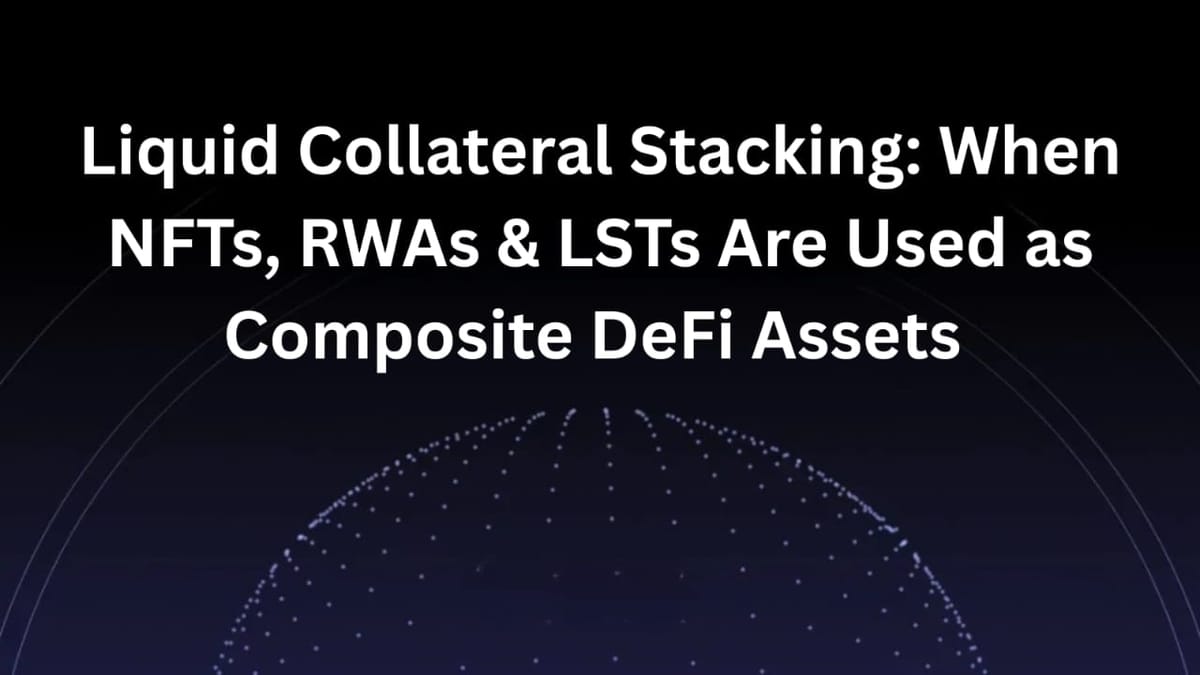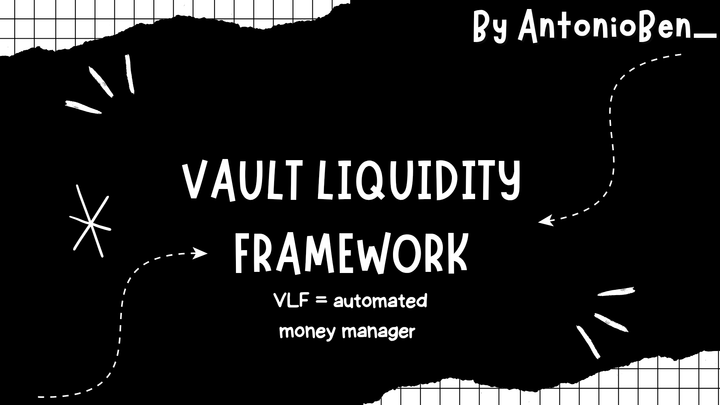Liquid Collateral Stacking: When NFTs, RWAs & LSTs Are Used as Composite DeFi Assets

Introduction
The decentralized finance (DeFi) landscape is continuously evolving, with innovative financial products and services emerging to enhance capital efficiency and liquidity. One of the most exciting developments in this space is the concept of liquid collateral stacking, which involves the use of diverse asset classes such as Non-Fungible Tokens (NFTs), Real-World Assets (RWAs), and Liquid Staking Tokens (LSTs) as composite assets in DeFi protocols. This article explores the mechanics of liquid collateral stacking, its benefits, challenges, and the future of this innovative approach in the DeFi ecosystem.
1. Understanding Liquid Collateral Stacking
1.1 What is Liquid Collateral Stacking?
Liquid collateral stacking refers to the practice of using multiple types of collateral such as NFTs, RWAs, and LSTs together in a single DeFi vault or protocol. This approach allows users to leverage the value of their diverse assets to access liquidity, borrow funds, or participate in yield farming while maintaining exposure to their underlying assets.
1.2 Key Components of Liquid Collateral Stacking
- Non-Fungible Tokens (NFTs): Unique digital assets that represent ownership of a specific item or piece of content, such as art, music, or virtual real estate. In the context of liquid collateral stacking, NFTs can be used as collateral to secure loans or access liquidity.
- Real-World Assets (RWAs): Physical assets that have been tokenized and represented on the blockchain, such as real estate, commodities, or financial instruments. RWAs provide a bridge between traditional finance and DeFi, allowing users to leverage tangible assets in the digital economy.
- Liquid Staking Tokens (LSTs): Tokens that represent staked assets in a proof-of-stake (PoS) blockchain. LSTs allow users to earn staking rewards while maintaining liquidity, as they can be traded or used as collateral in DeFi protocols.
2. The Mechanics of Liquid Collateral Stacking
2.1 How Liquid Collateral Stacking Works
Liquid collateral stacking operates through a series of steps that facilitate the use of multiple asset classes as collateral:
- Asset Tokenization: The first step involves tokenizing the assets that will be used as collateral. This can include minting NFTs for digital art, creating tokenized representations of RWAs, or issuing LSTs for staked assets.
- Vault Creation: Users can create a vault in a DeFi protocol that accepts multiple types of collateral. This vault will allow users to deposit their NFTs, RWAs, and LSTs as collateral.
- Collateral Valuation: The DeFi protocol will assess the value of the deposited collateral, taking into account the market prices of the NFTs, RWAs, and LSTs. This valuation is crucial for determining the amount of liquidity or borrowing power available to the user.
- Liquidity Access: Once the collateral is deposited and valued, users can access liquidity in the form of stablecoins or other digital assets. This liquidity can be used for various purposes, such as trading, yield farming, or investing in other DeFi projects.
- Collateral Management: Users can manage their collateral by adding or removing assets from the vault as needed. This flexibility allows users to optimize their capital efficiency and adapt to changing market conditions.
2.2 Benefits of Liquid Collateral Stacking
- Enhanced Capital Efficiency: By allowing users to leverage multiple asset classes, liquid collateral stacking increases capital efficiency. Users can access liquidity without having to sell their underlying assets, enabling them to maintain exposure to their investments.
- Diversification: Liquid collateral stacking promotes diversification by allowing users to combine different types of collateral. This can help mitigate risks associated with price volatility in any single asset class.
- Increased Liquidity: The use of NFTs, RWAs, and LSTs as collateral can enhance liquidity in the DeFi ecosystem. By tokenizing real-world assets and allowing them to be used in DeFi protocols, more capital can flow into the space.
- Access to New Markets: Liquid collateral stacking opens up new markets for DeFi participants. For example, tokenized real estate can provide access to a previously illiquid asset class, allowing users to invest in real estate without the barriers of traditional finance.
- Yield Generation: Users can earn yield on their collateral while accessing liquidity. For instance, staked assets represented by LSTs can continue to earn staking rewards while being used as collateral in a DeFi protocol.
3. Challenges of Liquid Collateral Stacking
1. Complexity and Risk Management
While liquid collateral stacking offers numerous benefits, it also introduces complexities and risks that users must navigate:
- Valuation Challenges: Accurately valuing NFTs, RWAs, and LSTs can be challenging due to market volatility and the unique nature of each asset. Fluctuations in asset prices can impact the collateralization ratio and the user's ability to access liquidity.
- Smart Contract Risks: DeFi protocols rely on smart contracts to manage collateral and execute transactions. Vulnerabilities in these contracts can expose users to risks, including potential loss of funds.
- Regulatory Uncertainty: The regulatory landscape for DeFi and tokenized assets is still evolving. Users must be aware of potential regulatory changes that could impact the use of RWAs and NFTs in DeFi.
- Market Liquidity: While liquid collateral stacking can enhance liquidity, the actual market liquidity for certain assets, particularly NFTs and RWAs, may be limited. This can create challenges when users need to liquidate their collateral.
2. Security Concerns
Security is a paramount concern in the DeFi space, and liquid collateral stacking is no exception:
- Custodial Risks: If a DeFi protocol requires users to deposit their assets into a custodial wallet, there is a risk of hacks or mismanagement of funds. Users should carefully evaluate the security measures in place before participating.
- Counterparty Risks: When using RWAs as collateral, users may face counterparty risks associated with the underlying asset. For example, if the asset is tied to a physical property, issues related to ownership or legal disputes could arise.
- Liquidity Risks: In times of market stress, the liquidity of certain assets may dry up, making it difficult for users to exit positions or liquidate collateral. This can lead to forced liquidations and losses.
4. Case Studies of Liquid Collateral Stacking
1. NFT Collateralization
Several DeFi platforms have begun to accept NFTs as collateral for loans. For example, platforms like NFTfi allow users to deposit their NFTs and receive loans in stablecoins. The value of the NFT is assessed based on market prices, and users can reclaim their NFTs by repaying the loan.
Benefits:
- Access to Liquidity: NFT owners can access liquidity without selling their valuable digital assets.
- Preservation of Ownership: Users maintain ownership of their NFTs while leveraging their value for borrowing.
Challenges:
- Valuation Volatility: The value of NFTs can fluctuate significantly, impacting the collateralization ratio and loan terms.
- Market Demand: The liquidity of NFTs can vary based on market demand, making it challenging to liquidate collateral.
2. Tokenized Real Estate
Tokenized real estate platforms, such as RealT, allow users to invest in fractional ownership of properties through tokenized assets. These tokens can be used as collateral in DeFi protocols, enabling users to access liquidity while maintaining exposure to real estate investments.
Benefits:
- Diversification: Investors can diversify their portfolios by gaining exposure to real estate without the barriers of traditional investing.
- Passive Income: Tokenized real estate can generate rental income, providing additional yield for investors.
Challenges:
- Regulatory Compliance: Tokenized real estate must comply with local regulations, which can vary by jurisdiction.
- Market Liquidity: The liquidity of tokenized real estate assets may be limited, impacting the ability to exit positions.
3. Liquid Staking Tokens
Liquid staking platforms, such as Lido, allow users to stake their assets while receiving LSTs in return. These LSTs can be used as collateral in DeFi protocols, enabling users to earn staking rewards while accessing liquidity.
Benefits:
- Earning Rewards: Users can earn staking rewards while maintaining liquidity through LSTs.
- Capital Efficiency: Liquid staking enhances capital efficiency by allowing users to leverage their staked assets.
Challenges:
- Smart Contract Risks: Users must trust the underlying smart contracts of the liquid staking platform.
- Market Volatility: The value of LSTs can fluctuate based on market conditions, impacting collateralization ratios.
5. The Future of Liquid Collateral Stacking
5.1 Trends to Watch
- Increased Adoption: As DeFi continues to grow, the adoption of liquid collateral stacking is expected to increase. More platforms will likely emerge that accept diverse asset classes as collateral.
- Interoperability: The future of liquid collateral stacking will likely involve greater interoperability between different DeFi protocols, allowing users to seamlessly move assets across platforms.
- Enhanced Valuation Mechanisms: Innovations in valuation mechanisms, such as decentralized oracles, will improve the accuracy of asset valuations, reducing risks associated with collateralization.
- Regulatory Clarity: As regulators develop clearer frameworks for DeFi and tokenized assets, users will gain more confidence in participating in liquid collateral stacking.
- Integration with Traditional Finance: The integration of RWAs into DeFi will continue to bridge the gap between traditional finance and the decentralized economy, providing new opportunities for investors.
Conclusion
Liquid collateral stacking represents a significant advancement in the DeFi landscape, allowing users to leverage diverse asset classes for improved capital efficiency and liquidity. By integrating NFTs, RWAs, and LSTs as composite assets, DeFi protocols can enhance user experiences and create new opportunities for investment and borrowing. However, challenges related to valuation, security, and regulatory compliance must be addressed to ensure the long-term success of this innovative approach. As the DeFi ecosystem continues to evolve, liquid collateral stacking will play a crucial role in shaping the future of decentralized finance.



Comments ()